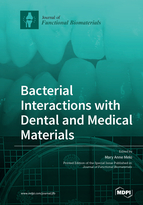Bacterial Interactions with Dental and Medical Materials
A special issue of Journal of Functional Biomaterials (ISSN 2079-4983).
Deadline for manuscript submissions: closed (30 June 2020) | Viewed by 66891
Special Issue Editor
Interests: oral biofilm; dental materials; dental caries; biomaterials
Special Issues, Collections and Topics in MDPI journals
Special Issue Information
The aim of this Special Issue is to present the current scenario of bacteria interactions with biomaterials’ surfaces through original research articles and timely reviews on this subject.
The interaction of bacteria with biomaterials’ surfaces has important clinical implications due to biofilm formation and biofouling. Although biofilms play an important positive role in a variety of ecosystems, they also have many negative effects, including biofilm-related infections in medical and dental settings.
Biofilms account for up to 80% of the total number of bacteria-related infections, including endocarditis, cystic fibrosis, secondary dental caries, periodontitis, rhinosinusitis, osteomyelitis, non-healing chronic wounds, meningitis, kidney infections, and prosthesis- and implantable device-related infections.
Despite efforts to maintain sterility, implantable and restorative medical and dental materials can easily become colonized by bacteria. Major challenges in treating biofilm-related infections are their difficult diagnosis and eradication due to a high tolerance of bacteria to antibiotics.
Many of the interactions of bacteria with surfaces may produce changes in cell morphology and behavior. The current development of nanobiotechnologies also requires a better understanding of cell–surface interactions at the nanometer scale.
This Special Issue calls for recent studies from a range of fields in science and engineering that are poised to guide investigations on tissue-contacting biomaterials to control healing and susceptibility to bacterial colonization and understand mechanisms, clinical perspectives, etc., which, overall, will be beneficial to healthcare.
We invite manuscripts that focus on a wide range of issues and concerns regarding Bacterial Interactions with Dental and Medical Materials including, but not limited to:
- Clinical perspectives for device-associated infections
- Infection models investigating materials’ interaction
- Bacterial response to dental and medical materials’ surfaces
- Antibiofilm-Containing Dental and Medical Devices
- Biomimetic and Antimicrobial Nanotechnology applied to dental and medical materials
- Antibacterial stewardship on biomaterial design and development
- Infection-resisting biomaterials
We very much look forward to your valuable contribution.
Prof. Dr. Mary Anne Melo
Guest Editor
Manuscript Submission Information
Manuscripts should be submitted online at www.mdpi.com by registering and logging in to this website. Once you are registered, click here to go to the submission form. Manuscripts can be submitted until the deadline. All submissions that pass pre-check are peer-reviewed. Accepted papers will be published continuously in the journal (as soon as accepted) and will be listed together on the special issue website. Research articles, review articles as well as short communications are invited. For planned papers, a title and short abstract (about 100 words) can be sent to the Editorial Office for announcement on this website.
Submitted manuscripts should not have been published previously, nor be under consideration for publication elsewhere (except conference proceedings papers). All manuscripts are thoroughly refereed through a single-blind peer-review process. A guide for authors and other relevant information for submission of manuscripts is available on the Instructions for Authors page. Journal of Functional Biomaterials is an international peer-reviewed open access monthly journal published by MDPI.
Please visit the Instructions for Authors page before submitting a manuscript. The Article Processing Charge (APC) for publication in this open access journal is 2700 CHF (Swiss Francs). Submitted papers should be well formatted and use good English. Authors may use MDPI's English editing service prior to publication or during author revisions.
Keywords
- biofilms
- infections
- nanostructured materials
- antibacterial
- biomaterials
- biomaterial-associated infection
- bacteria
- dental
- medical







